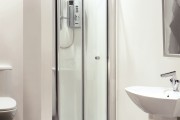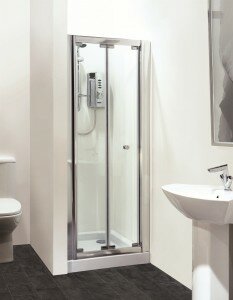
Episode 1: Introduction to Shower Enclosures
Posted on 20. Mar, 2012 by Nitin in Advice
The decision to install a large shower enclosure can be a large financial commitment, and scheduling the work required to strip out the old bathroom and install the new can bring other pressures as well. Which is why it is important to take the time to select the right shower enclosure in the first instance. There are a number of different enclosure styles available, with the main difference between the styles of door:
Folding Door: (Bi-Fold)
In these enclosures, the door folds in the middle and slides to the side, always opening inwards; these provide a great space saving option.
Sliding Door: (Sliding, Quadrant)
The sliding shower doors provide complete ease of opening. While the Quadrant styles are ideally placed to make the most of the corner of rooms, because generally the doors open from a central position. The Sliding styles are designed for slightly larger bathrooms (the largest enclosure extends to 1400mm in width).
Hinged Door: (Pivot)
The hinged door provides a sturdy, wide opening to the enclosure.
No Door: (Wet Room, Walk-In)
With no moving parts, these enclosures provide an open finish. The Walk-In enclosure can be installed with a tray, or installed as an alternative to the Wet Room.
Corner or Alcove?
You also have two options when installing a new enclosure. You can install a corner enclosure, which features the door and side panel in any corner of your bathroom.
Alternatively, with just a door panel, you can convert any bathroom alcove into an enclosure. Instead of using these areas for storage, purchase a tray to fit the space, and let the single door panel cover the length completely. Should you wish to add an alcove in an existing bathroom, simply construct a stud wall in the desired location.

A Bi-Fold Shower Enclosure, installed in an alcove.
These are some key things to look out for when buying a shower enclosure:
Quality of the glass – Always look out for tempered shower glass, as the manufacturing process heats and cools the glass several times. This provides an incredibly strong safety glass which should meet BS6202 standards.
Quality fittings – Molten metal is forced into a cavity at high pressure, and this is known as solid die casting. When this is done in a single mould, a quality fitting is produced as there is less chance of breakage.
Metal rollers – Too many shower enclosures have a single roller attachment. However, problems can occur if the roller detaches itself. A better solution is to have both rollers attach themselves on the top and bottom of the door to prevent such accidents.
